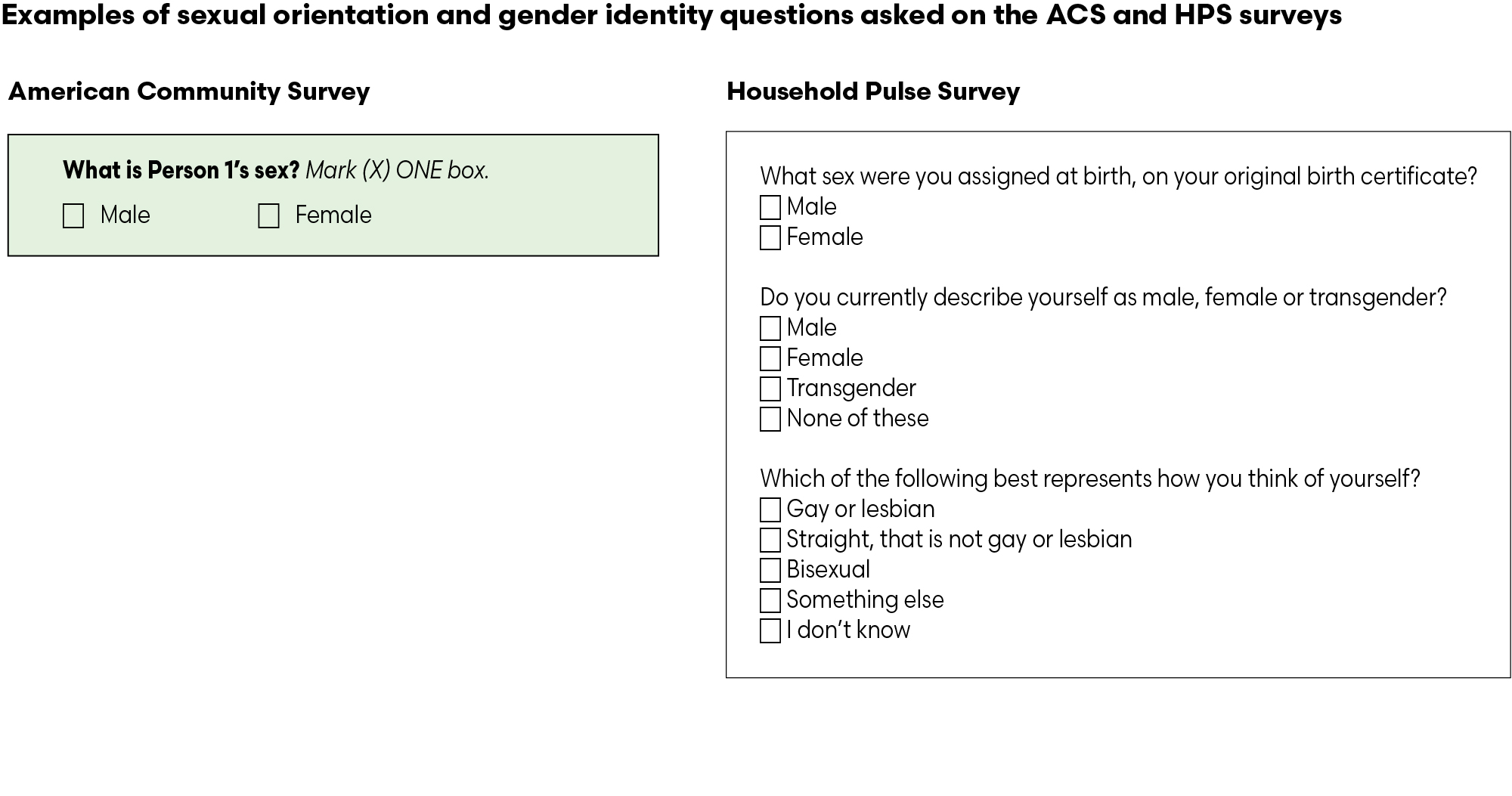In honor of Pride Month, Minnesota Compass looked into what current demographic tools can, and can’t, tell us about LGBTQ+ Minnesotans and their households. We also give some background on why accurate data are so hard to come by, and how that may change.
1 in 100 Minnesotans? Or 1 in 9?
The primary tool that we use on Minnesota Compass, the U.S. Census Bureau’s American Community Survey (ACS), shows about 35,000 Minnesota adults living with a spouse or partner of the same sex in 2022, or about 1% of Minnesota adults. But the Household Pulse Survey (HPS), also from the U.S. Census Bureau, found more than 460,000 LGBTQ+ Minnesota adults in March of 2024. That’s about 11% of adults in the state!

So which is it? It depends on how you ask the question!
Why such a large difference? Much of it comes down to the fact that the HPS asks about LGBTQ+ identity directly. The survey asks both, “What sex were you assigned at birth, on your original birth certificate?” and “Do you currently describe yourself as male, female or transgender?” (with an option for “None of these”). It also asks “Which of the following best represents how you think of yourself?” with options for “Gay or lesbian,” “Straight, that is not gay or lesbian,” “Bisexual,” “Something else,” and “I don’t know.”
The ACS only asks the sex of each person in the household, with “Male” and “Female” as the only options.
That difference allows the HPS to capture a large number of LBGTQ+ Americans that the ACS misses. LGBTQ+ people who do not live with a partner, non-binary and transgender people, bisexual or pansexual people in different-sex partnerships, and many others can be counted in the HPS, but not in the ACS.

What can we learn from the data sources we have?
Minnesota Compass has put together three short posts on what we can learn from the data sources we currently have.
- Same-sex couples who live together (via the American Community Survey): Although the ACS does not ask about sexual orientation directly, and only offers male/female options for gender, the fact that it is a large sample with a broad range of questions can help us get a picture of same-sex-couple households in Minnesota.
- LGBTQ+ adults (via the Household Pulse Survey): Because the Household Pulse Survey asks about sexual orientation and gender identity directly, it allows us to get a fuller picture of who is in Minnesota’s LGBTQ+ community. It also asks some mental health questions that are not in the ACS, which add nuance on qualify of life. It is a smaller and less robust sample than the ACS, but it does give us a chance to check whether the patterns we see among same-sex couples in the ACS extend to the broader LBGTQ+ community.
- LGBTQ+ children and youth: Neither the ACS nor the HPS provide information on LGBTQ+ youth. However, the Minnesota Student Survey does ask questions about sexual orientation and gender identity of Minnesota 8th, 9th, and 11th graders, and can help to give us a picture of the youth community.
ACS may soon give us a clearer picture of the LGBTQ+ community
The Census Bureau is looking into adding questions to the American Community Survey to capture sexual orientation and gender identity. Last month, the U.S. Census Bureau published a Federal Register notice giving the public a final opportunity to provide feedback on new survey items before the Census Bureau submits its recommendations to the Office of Management and Budget for approval. Feedback was accepted through May 30, 2024.
The addition of these survey items would allow projects like Minnesota Compass as well as advocacy organizations to get a better picture of the number of LGBTQ+ Minnesotans regardless of partnership status, as well as their demographic, economic, and housing characteristics. Hopefully growing awareness of the size and needs of the LGBTQ+ population can provide a push towards advocating for collecting more complete data, so that we can paint a fuller and more nuanced picture of these communities going into the future.
Other articles and interactives
- What the 2020 census can — and can't — tell us about LGBTQ+ people by Hansi Lo Wang and Connie Hanzhang Jin
- “Why aren’t I represented on Compass?” by Anne Li
- Who counts, and how to be counted by Laura Schauben
READ THE ENTIRE SERIES
Part 1: What current demographic tools can, and can’t, tell us about LGBTQ+ Minnesotans and their households
Part 2: Same-sex couples as self-identified in the American Community Survey
Part 3: LGBTQ+ adults as self-identified in the Household Pulse Survey
Part 4: LGBTQ+ youth and children as self-identified in the Minnesota Student Survey
Our thanks to Dr. Kay Simon, assistant professor at the University of Minnesota Department of Family Social Science, for reviewing this series.
